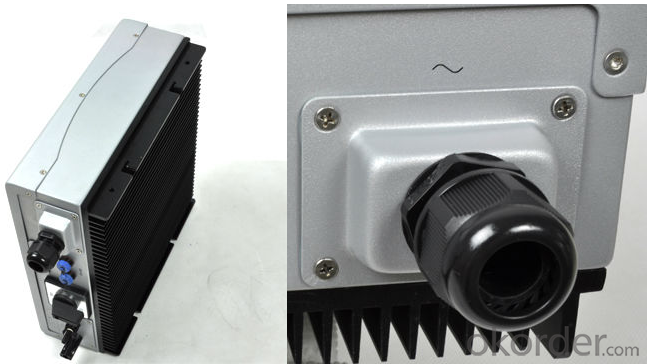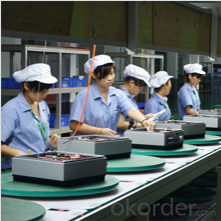Solar Inverter with Transformer 2000HF-3000HF
- Loading Port:
- Shekou
- Payment Terms:
- TT or LC
- Min Order Qty:
- 10 pc
- Supply Capability:
- 10000 pc/month
OKorder Service Pledge
OKorder Financial Service
You Might Also Like
Solar inverter with transformer 2000HF-3000HF
Specifications
>Maximum efficiency of 96%
>DC switch optional
>High frequency transformer topology
>MTL-String
>Bluetooth technology
Leading - edge Technology
>Maximum efficiency of 96% and wide input voltage range
>DC switch optional
>High frequency transformer topology
>MTL-String
>Bluetooth technology
>Sound control
>Fanless cooling concept
>Easy installation
>High reliability
>Bluetooth technology


| Model | 2000HF | 2500HF | 3000HF |
| Max. DC power | 2100W | 2600W | 3170W |
| MAX. input current | 12A | 15A | 15A |
| Numbers of MPP tracker | 1 | ||
| Nominal DC voltage | 450 VDC | ||
| Maximum PV open voltage | 600V | ||
| MPPT voltage rang (Vdc) | 175~500 | ||
| MPPT efficiency at output > 10% | > 99% | ||
| System start-up voltage | 100VDC | ||
| Working voltage range(Vdc) | 100 ~ 600 | ||
| Initial feeding voltage | 200 VDC | ||
| Shutdown voltage | 70 VDC typical | ||
| DC voltage ripple | < 5% | ||
| Output data (AC side) | |||
| Model | 2000HF | 2500HF | 3000HF |
| Nominal output power ( 230V/50Hz) | 2000W | 2500W | 3000W |
| Maximum output power | 2000VA | 2500VA | 3000VA |
| Nominal AC voltage | 220V, 230V, 240V | ||
| Operational AC voltage range | 180V~280V | ||
| Operational AC frequency range | 45Hz~65Hz | ||
| AC power frequency | 50Hz/60Hz | ||
| Rated power frequency/Rated power voltage | 50Hz/230V | ||
| Maximum output current (AAC,RMS) | 11.4A | 14.2A | 15.0A |
| DC injection(mA, DC) | <0.5%< td=""> | <0.5%< td=""> | <0.5%< td=""> |
| O/P current distortion at full rating | <3%< td=""> | ||
| Power Factor at full rating | >0.99 | ||
| Active anti-islanding | yes | ||
| Model | Growatt | Growatt | Growatt |
| 2000 HF | 2500 HF | 3000 HF | |
| Night power consumption | <1w< td=""> | ||
| Maximum conversion efficiency (DC/AC) | 0.96 | 0.96 | 0.96 |
| European Efficiency | 0.955 | 0.955 | 0.955 |
| Topology | HF transformer | ||
| HF transformer | |||
| HF transformer | |||
| Protection degree | IP65 | ||
| IP65 | |||
| Operation temperature | -25 to 60ºC | ||
| Humidity | 0 to 95%, non-condensing | ||
| Heat Dissipation | Convection | ||
| Acoustic noise level | <25dba< td=""> | ||
| Altitude | Up to 2000m without power derating | ||
| Dimensions (W/H/D) in mm | 452/450/130 | 452/450/130 | 452/450/130 |
| Weight in kg | 17.06 | 17.06 | 17.06 |
| Certificates and Approvals | VDE0126 - 1 - 1 ,CE , RD1663 , G83 | ||
FAQ
1. Have any design tool and how to use it?
Shine Design is the system design software just for inverters, It can conduct installers to figure out panel numbers for a system, panel numbers for each string, and which inverter model is suitable for the system. Moreover, it can print a design report after input all necessary parameters, can calculate DC/AC wire wastage, annual generation, etc.
2. Does the inverter have monitoring solutions for residential system?
For small rating system, we have wired two monitoring solution (ShineNet via RS232 or RS485). (a) Local wireless monitoring solution (ShineVision via RF module communication) (b) Global wireless monitoring solution (WIFI module via WIFI network)
3. Do you have free solution for monitoring?
ShineNet is an inverter monitoring software run in Windows XP, Windows Vista, Windows 7 operating system. It can monitor inverter via RS232 (or RS232 convert to USB cable) and RS485 wire connection. Customers can purchase the cable locally to get the inverter monitored, it is simple.
- Q:How do you calculate the efficiency of a solar inverter?
- To calculate the efficiency of a solar inverter, you need to divide the output power by the input power and multiply it by 100. The formula is: Efficiency = (Output Power / Input Power) * 100.
- Q:What is the warranty period for a solar inverter?
- The warranty period for a solar inverter can vary depending on the manufacturer and model, but it typically ranges from 5 to 10 years.
- Q:How does MPPT improve the efficiency of a solar inverter?
- MPPT (Maximum Power Point Tracking) improves the efficiency of a solar inverter by continuously adjusting the operating point of the solar panels to ensure they are producing maximum power. This is achieved by maximizing the voltage and current output of the panels, which allows the inverter to convert more of the available solar energy into usable electricity. By constantly tracking the maximum power point, MPPT ensures that the solar inverter operates at its highest efficiency, resulting in increased overall system efficiency and improved energy generation.
- Q:What is the maximum short-circuit current that a solar inverter can handle?
- The maximum short-circuit current that a solar inverter can handle varies depending on the specific model and design. However, most solar inverters are designed to handle short-circuit currents ranging from 500 Amps to 10,000 Amps, depending on the size and capacity of the inverter.
- Q:What are the key factors affecting the warranty coverage of a solar inverter?
- The key factors affecting the warranty coverage of a solar inverter include the length of the warranty period, the reputation and reliability of the manufacturer, the quality of the components used in the inverter, any specified usage restrictions or limitations, and the level of technical support and after-sales service provided by the manufacturer.
- Q:Can a solar inverter be used with a solar-powered educational system?
- Yes, a solar inverter can be used with a solar-powered educational system. A solar inverter is responsible for converting the direct current (DC) produced by solar panels into alternating current (AC) that can be used to power electrical devices. In the case of a solar-powered educational system, the solar inverter plays a crucial role in converting the DC energy generated by the solar panels to AC energy that can be utilized by the educational equipment, such as computers, projectors, or other electrical devices, thereby enabling the system to function efficiently.
- Q:What is the role of a communication interface in a solar inverter?
- The role of a communication interface in a solar inverter is to allow for seamless communication between the inverter and other devices or systems, such as a solar monitoring system or a smart grid. It enables the inverter to transmit important data, such as energy production, performance metrics, and fault notifications, to the connected devices or systems. Additionally, it allows for remote monitoring and control of the inverter, enabling users to monitor and optimize the performance of their solar power system.
- Q:What is the role of a solar inverter in a utility-scale system?
- The role of a solar inverter in a utility-scale system is to convert the direct current (DC) electricity produced by the solar panels into alternating current (AC) electricity that can be fed into the utility grid. It also ensures the maximum power output of the solar panels by tracking the maximum power point. Additionally, the inverter provides grid synchronization and protection functions to ensure the safe and efficient operation of the utility-scale solar system.
- Q:What is the maximum current output of a solar inverter?
- The maximum current output of a solar inverter depends on various factors such as the size and capacity of the inverter, the number and capacity of the solar panels connected to it, and the specific technology and design of the inverter. Generally, solar inverters have a maximum current output ranging from a few amps to several hundred amps, with larger commercial-scale inverters having higher current outputs compared to residential or smaller scale inverters. It is crucial to select an inverter that can handle the current requirements of the solar panel system to ensure optimal performance and safety.
- Q:What is the importance of surge protection in a solar inverter?
- Surge protection is of utmost importance in a solar inverter due to several reasons. Firstly, solar inverters are responsible for converting the direct current (DC) generated by solar panels into alternating current (AC) that can be used to power electrical devices. During this conversion process, there is a potential for power surges or voltage spikes to occur. These surges can damage the sensitive electronic components within the inverter, leading to malfunctions or complete failure. Secondly, solar inverters are often connected to the electrical grid, allowing excess electricity generated by the solar panels to be fed back into the grid. However, the grid can be prone to power fluctuations and surges caused by lightning strikes, utility switching, or other external factors. Without adequate surge protection, these power surges can travel back through the grid and damage the solar inverter. Furthermore, surge protection is essential in safeguarding the entire solar power system. In addition to the solar inverter, there are other components such as charge controllers, battery systems, and monitoring equipment that are interconnected. A surge in any part of the system can potentially damage or disrupt the entire system's operation. By installing surge protection devices, such as surge suppressors or surge arresters, in the solar inverter, the excess energy from power surges is diverted away from the sensitive electronic components. These devices are designed to absorb or redirect the surge, protecting the inverter and other connected equipment. In conclusion, surge protection is crucial in a solar inverter to prevent damage from power surges during the conversion process, protect against external power fluctuations from the grid, and safeguard the entire solar power system. Investing in proper surge protection ensures the longevity and reliable operation of the solar inverter, minimizing the risk of costly repairs or replacements.
1. Manufacturer Overview |
|
|---|---|
| Location | |
| Year Established | |
| Annual Output Value | |
| Main Markets | |
| Company Certifications | |
2. Manufacturer Certificates |
|
|---|---|
| a) Certification Name | |
| Range | |
| Reference | |
| Validity Period | |
3. Manufacturer Capability |
|
|---|---|
| a)Trade Capacity | |
| Nearest Port | |
| Export Percentage | |
| No.of Employees in Trade Department | |
| Language Spoken: | |
| b)Factory Information | |
| Factory Size: | |
| No. of Production Lines | |
| Contract Manufacturing | |
| Product Price Range | |
Send your message to us
Solar Inverter with Transformer 2000HF-3000HF
- Loading Port:
- Shekou
- Payment Terms:
- TT or LC
- Min Order Qty:
- 10 pc
- Supply Capability:
- 10000 pc/month
OKorder Service Pledge
OKorder Financial Service
Similar products
New products
Hot products
Hot Searches
Related keywords

































